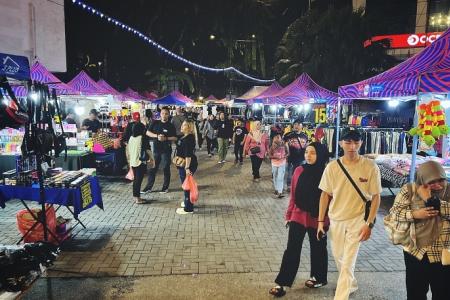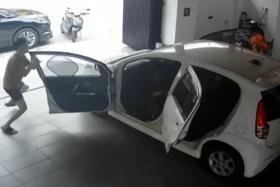Fewer S'pore customers in JB since VEP rule kicked in
Mr Chan Wah Heng decided to step away from his usual spot at the cash register and could be heard calling out to potential patrons to stop for brunch at his bak kut teh and seafood joint on Oct 5.
The owner of Wah Heng Bak Kut Teh, located next to the popular shopping mall KSL City in Johor Bahru, had felt something was amiss throughout the week as his restaurant was quieter, with fewer meals served.
“It was really weird. The week was so quiet,” Mr Chan, 60, told The Straits Times. He has since realised that the slump in footfall was caused by fewer Singaporeans driving into JB after the new Vehicle Entry Permit (VEP) rule kicked in on Oct 1.
Many Singaporeans had avoided entering Malaysia via the two land crossings over the last few days, with 20 per cent fewer vehicles entering from Singapore on Oct 1, The Star newspaper quoted a Home Ministry official as saying.
The good news is that Malaysia has delayed the strict implementation of the VEP regulation as the authorities rush to ensure that more owners of Singapore-registered vehicles get their permits, issuing errant drivers with only a written warning to do so.
“The authorities already said that they won’t issue any fines, so more must be done to tell them (Singaporeans) to not worry too much,” Mr Chan said, adding that 70 per cent of his customers are Singaporean.
The VEP, which comes with a radio frequency identification (RFID) tag, allows the Malaysian authorities to identify foreign-registered vehicles, enabling them to track traffic offences and outstanding summonses.
Some 20 shopkeepers and mall visitors in JB whom ST spoke to between Oct 3 and 5 said there had been a noticeable drop in footfall over the last few days.
Ms Mei Wong, 30, a retail manager selling travel luggage in KSL City mall, said she was also feeling the pinch. She had sold only one set of wheeled suitcases by noon on Oct 5, compared with selling about 30 pieces of luggage daily in the previous week.
“At this rate, it’s tough to reach break-even on the rent,” she said. Her company had rented a large space on the ground floor of the mall until November.
SSI Maju Express car wash worker Muhammad Rabin said he is worried that he may not get his usual daily wages at the end of Oct 5. His team of three men had managed to secure only one client in the lot behind KSL City, and the clock was quickly ticking towards noon.
“We need to hit about 30 cars a day to get our salary plus commission of about RM60 (S$18.50),” said the 26-year-old.
Interviews with business owners and visitors at several shopping districts popular with Singaporeans found that some of the crowd appeared to have returned, but shopkeepers say the vibe on Oct 4 was significantly quieter than in previous pre-weekend evenings.
Stall operators at Pasar Karat, a night flea market, said they have suffered a 30 to 40 per cent plunge in sales since Oct 1. When asked if he knew about the VEP rules, clothes seller Faizal Abdullah said: “Maybe that’s why it’s been weirdly quiet.”
A waiter at Made on Monday, a late-night cafe some 5km from the city centre in Jalan Abdul Samad 1, said that the empty tables on Oct 4 evening was “extremely unusual”.
Singaporeans, he said, tend to come in waves from 9pm, and they would queue to get a seat to enjoy coffee and Italian food, and to smoke shisha, flavoured tobacco smoked through a pipe.
On Oct 5 evening, live camera feed of the Causeway and Second Link in Tuas from the Land Transport Authority’s (LTA) One Motoring website showed a long line of vehicles queueing up to enter JB.
But it still looked to be shorter than the snaking lines often seen on weekends.
Checks using the Beat The Jam app showed the average waiting time at the Causeway was around 50 minutes throughout the morning from 7am. The average waiting time was still 50 minutes at around 6pm.
Several Singapore shoppers told ST on Oct 5 said they felt that the visitors from the Republic were back in full force.
At Jalan Dhoby, a street known for its traditional bakeries, long queues were seen at coffee shops and cafes at around 9am.
A 23-year-old Singaporean aviation worker, who wanted to be known only as Ms Chua, said Jalan Dhoby was quite packed and it was hard to book a Grab ride out of the area.
Asked about his view on whether the VEP would deter Singaporeans from entering JB, businessman Lee Wan Choy, 66, said: “Things will eventually square out to be the same as before. And this thing will stabilise sooner or later.”
When the same question was posed to Mr Hazeem Esman, 27, a social development officer from Singapore, he said: “I think Singaporeans will still come to Johor with or without the VEP. Nothing replaces the many choices of things to do and buy here.”
Meanwhile, queues at the TCsens VEP collection centre in Danga Bay showed no signs of easing when ST visited the area on Oct 4.
Singaporean motorists were coming in with technical issues, including needing to replace their RFID tags and deregister an existing tag.
Mr Saifuddin Zahir, an outdoor adventure consultant, said he queued from 9.30am to around 5.30pm to get his tag replaced.
He said the tag which he received by post on the first week of September and fixed on the headlight himself could not be read at the immigration booth.
“It’s quite disappointing for us because the application and registration process was fairly smooth, but at the last stage, when we finally receive the tag and installed it, the message displayed at the checkpoint counter said it can’t be read. Now, it’s almost back to square one because we need to deregister the current tag and get a new one again.”
Get The New Paper on your phone with the free TNP app. Download from the Apple App Store or Google Play Store now


